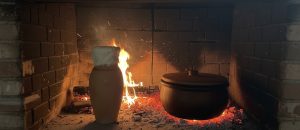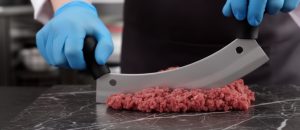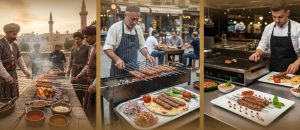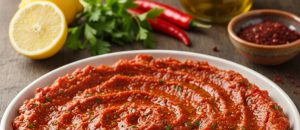Kebab, in its myriad forms, is more than just a culinary tradition; it is a profound testament to humanity’s enduring ingenuity in harnessing fire and technology for sustenance and flavor. The journey of kebab cooking methods—from simple pieces of meat threaded onto sticks to the elaborate, continuously rotating vertical spits—reflects a fascinating technological and cultural evolution spanning millennia. This in-depth article, a vital Cluster Content piece supporting our “Döner Kebab: Atlas of History and Varieties” Pillar Page, will meticulously chart this progression. For food historians, culinary scientists, and enthusiasts, we will explore the ancient origins of grilling, delve into the sophisticated horizontal and vertical rotisseries of the Ottoman Empire, and examine other traditional cooking technologies that define the diverse world of kebab. Join us as we uncover how continuous innovation, driven by both necessity and a quest for perfection, has shaped the enduring legacy of kebab cooking.
The Ancient Flame: Tracing the Origins of Kebab Cooking
The earliest forms of kebab cooking are as old as humanity’s mastery of fire, representing a fundamental and universal method of preparing meat that predates complex culinary technologies. The simple act of exposing meat to direct heat quickly became an indispensable technique for survival and social gathering, laying the groundwork for all future advancements.
The Primacy of the Skewer: Humanity’s First Grilling Tool
The skewer, in its most rudimentary form, was likely one of the earliest tools used by humans to cook meat over an open flame, offering practicality and efficiency.
- Paleolithic Origins: Archaeological evidence from various prehistoric sites worldwide indicates that early hominids used sharpened sticks to impale pieces of meat, fish, or even vegetables, holding them over open fires. This was a direct and effective way to cook food, especially during the Paleolithic era when hunting provided sustenance.
- Efficiency and Control: Skewering allowed for individual portions to be cooked, preventing wastage and ensuring that meat cooked more evenly than if placed directly on embers. It also provided a degree of control over the cooking process, allowing for rotation to prevent burning.
- Cultural Universality: This basic technique is remarkably universal across different cultures and continents, suggesting it was independently discovered multiple times due to its inherent practicality. The concept of “meat on a stick” is a primal culinary expression.
- Precursor to Kebab: This simple, ancient skewer is the direct ancestor of the “şiş” (skewer) in Şiş Kebap, highlighting an unbroken lineage of grilling technology that has survived for millennia.
Early Hearth and Pit Cooking: Efficiency and Flavor
Beyond direct skewering, early humans and ancient civilizations also developed more contained methods of fire cooking, such as hearths and pit ovens, to enhance efficiency and flavor.
- Hearth Cooking: Simple hearths, where a fire was built and food cooked directly on or beside it, were fundamental. Meat could be laid on hot stones or wrapped in leaves and placed in embers.
- Pit Ovens: Pit ovens, often precursors to modern tandoors, involved digging a hole in the ground, building a fire within it, and then placing food (often sealed in clay or leaves) inside after the fire died down, using the retained heat to cook slowly.
- Benefits: This method provided stable, indirect heat, allowing for longer, slower cooking. It trapped moisture, leading to more tender meats, and infused food with smoky, earthy flavors. It was also efficient in fuel usage.
- Early Stewing: These enclosed cooking methods also allowed for rudimentary stewing or braising, softening tougher cuts of meat and allowing flavors to meld. Testi Kebabı’s clay pot cooking is a direct descendant of these pit-cooking traditions.
- Technological Advancement: These methods represented a technological advancement from open-fire grilling, demonstrating an early understanding of heat retention, moisture management, and flavor development, laying the foundation for more sophisticated ovens and rotisseries.
The Horizontal Revolution: Early Rotisseries and Large-Scale Roasting
The evolution from static skewering to dynamic rotation marked a significant advancement in kebab cooking, allowing for more even cooking and larger-scale preparation. The horizontal rotisserie, in various forms, became a popular method, particularly suited for roasting whole animals or substantial portions of meat.
The Ottoman Table: Sophistication in Horizontal Spit Roasting
During the Ottoman Empire, horizontal spit roasting reached a high degree of sophistication, becoming a central feature of palace banquets and elaborate feasts.
- “Kuzu Çevirme” (Spit-Roasted Lamb): A prime example is “Kuzu Çevirme,” where a whole lamb (or large sections) is seasoned and slowly roasted on a horizontal spit over an open fire or coals. This method ensures remarkably tender and juicy meat with a crispy skin.
- Palace Cuisine: Ottoman palace chefs perfected techniques for horizontal roasting, often employing specialized mechanical spits that could be slowly turned, sometimes by water power or manual labor. This allowed for precise control over the cooking process, essential for delicate meats and elaborate presentations.
- Flavor and Presentation: Horizontal roasting allowed for the meat to self-baste as it turned, with its fat dripping and coating the exterior, contributing to both flavor and a beautiful golden-brown crust. It was also a dramatic centerpiece for banquets.
- Efficiency: For feeding large gatherings, horizontal rotisseries were highly efficient, allowing for the simultaneous cooking of substantial amounts of meat.
Çağ Kebabı: A Masterpiece of Horizontal Rotation
From Erzurum, in Eastern Anatolia, comes Çağ Kebabı, a unique and highly prized form of Döner Kebab that is distinctively cooked on a horizontal spit, showcasing a specific mastery of horizontal rotation.
- Unique Design: Unlike the vertical Döner, Çağ Kebabı utilizes a horizontal rotisserie where large, marinated layers of lamb meat are pressed onto a thick, horizontal spit. The spit is placed over a wood fire.
- Marination: The lamb (often shoulder and leg) is marinated with a simple yet effective blend of onions, salt, and black pepper, which tenderizes the meat and infuses it with flavor.
- Cooking Process: As the horizontal spit slowly rotates, the meat cooks evenly, and its juices and fat continually baste the layers below. The wood fire imparts a deep, smoky flavor.
- Serving Innovation: A key technological aspect is the carving method. Thin slices of the cooked meat are shaved off the rotating horizontal spit onto small, individual skewers (çağ). These smaller skewers are then briefly grilled over hot coals to achieve a final crispy char before being served.
- Flavor and Texture: Çağ Kebabı is celebrated for its exceptional tenderness, rich smoky flavor, and slightly crispy edges, providing a distinct sensory experience from vertical Döner. It represents a pinnacle of horizontal rotisserie technology applied to kebab.
The Vertical Breakthrough: Döner Kebab and the Revolving Spit
The invention of the vertical revolving spit for Döner Kebab marked a revolutionary leap in kebab cooking technology, fundamentally altering how large quantities of meat could be prepared and served efficiently. This innovation, born in the Ottoman Empire, addressed long-standing challenges of even cooking and continuous service, paving the way for Döner Kebab’s global phenomenon.
İskender Efendi’s Innovation: The Birth of Vertical Roasting
While the concept of cooking meat on a spit was ancient, the specific innovation of cooking it vertically on a revolving spit is widely attributed to İskender Efendi of Bursa in the mid-19th century.
- Addressing Challenges: Traditional horizontal roasting of large meat masses often resulted in uneven cooking, with parts burning and others remaining undercooked, and carving was inefficient. İskender Efendi sought a better method.
- The Revolutionary Idea (circa 1867): He conceived the idea of stacking seasoned, thinly sliced meat (typically lamb) onto a vertical spit and cooking it in front of a heat source (originally a vertical wood fire or coals). The spit would rotate slowly.
- Key Advantages of Verticality:
- Even Heat Distribution: As the meat rotated, all sides were exposed to the heat, ensuring uniform cooking and browning.
- Self-Basting: A critical physical principle: as the fat from the upper layers melted, gravity caused it to drip down through the lower layers, continuously basting and keeping the entire cone succulent. This prevented dryness.
- Continuous Carving: The cooked, crispy outer layers could be shaved off continuously as needed, revealing fresh layers beneath to continue cooking. This made service highly efficient.
- Legacy: This innovation led to the creation of Iskender Kebabı, a dish named after him, which demonstrated the full potential of the vertical Döner cooking technology and quickly gained popularity.
The Engineering of the Vertical Spit: Heat, Gravity, and Precision
The vertical Döner spit is a marvel of culinary engineering, combining principles of heat transfer, gravity, and mechanical precision to create its distinctive product.
- Heating Elements: Early vertical spits used vertical charcoal or wood fires. Modern Döner grills typically employ vertical gas burners or electric heating elements, providing consistent and adjustable radiant heat. The heat source is positioned to directly face the rotating meat.
- Rotational Mechanism: A motor slowly rotates the spit, ensuring all parts of the meat cone are evenly exposed to the heat. The speed of rotation is carefully calibrated to allow for optimal cooking and browning without scorching.
- Gravity’s Role (Self-Basting): As discussed, gravity is central to the self-basting. The layered construction of meat and fat on the vertical spit allows melting fat to flow downwards, continuously moisturizing and flavoring the entire Döner mass. This intelligent design maximizes flavor and juiciness.
- Meat Construction: The meticulous stacking of meat layers, often interspersed with fat, is itself an engineering feat. It ensures the cone remains stable, cooks evenly, and provides a continuous supply of outer, cooked layers for carving.
- Precision Carving: The design is optimized for precision carving. Döner masters use long, sharp knives (or electric Döner knives) to shave off thin, even slices of perfectly cooked meat from the rotating spit. This ensures consistent texture and portion size. This combination of ancient principles and practical engineering makes the vertical Döner spit a highly effective and iconic cooking technology.
Beyond the Spit: Other Traditional Kebab Cooking Technologies
While skewers and spits dominate the kebab landscape, Anatolian cuisine also features a rich array of other traditional cooking technologies that produce distinctive kebab types, each with its own unique flavor profile and textural characteristics. These methods often involve enclosed cooking, utilizing residual heat or specialized ovens to achieve exceptional tenderness and flavor concentration.
Clay Pot Cooking: Testi Kebabı’s Sealed Environment
Testi Kebabı, particularly famous in Cappadocia, represents a unique method of enclosed, slow cooking in a sealed clay pot, a technology with ancient roots in Anatolia.
- The Clay Pot (Testi): A distinctive amphora-shaped clay pot with a narrow neck is used. It’s filled with meat (lamb, beef, or chicken), vegetables (tomatoes, peppers, onions, garlic), and spices.
- Sealing Technology: Crucially, the pot’s neck is sealed with a simple bread dough. This creates an airtight, pressurized environment inside the pot.
- Cooking Process: The sealed pot is then slow-cooked in a traditional tandır (tandoor) oven or a stone oven, or even a conventional oven.
- Scientific Principles: The sealed environment traps all the moisture and aromatic compounds, resulting in a self-steaming process. This facilitates the breakdown of tough collagen into gelatin, yielding incredibly tender meat and concentrated flavors. The internal pressure also helps to infuse flavors deeply.
- Dramatic Presentation: The breaking of the pot at the table is a dramatic culinary ritual, adding an element of surprise and theatre to the meal. This method showcases a different aspect of kebab cooking, focusing on slow, moist heat rather than direct grilling.
Tandoor and Stone Ovens: Earth-Baked Perfection
Tandoor and traditional stone ovens represent ancient and enduring cooking technologies, widely used across Anatolia and beyond for various baked and slow-cooked dishes, including certain forms of kebab.
- Tandoor Ovens (Tandır):
- Description: These are cylindrical clay or brick ovens, often partially or fully buried in the ground. A fire is built at the bottom, and once it dies down, the retained heat in the clay walls cooks the food.
- Kebab Application: Meat (sometimes skewered, sometimes in pots like Testi Kebabı, or even flatbreads with minced meat like lahmacun) is cooked by the radiant heat from the hot clay walls and the residual embers. The enclosed space creates a consistent, high-heat environment.
- Flavor: Tandoor cooking imparts a unique smoky, earthy flavor and produces incredibly tender meat due to the even, indirect heat.
- Stone Ovens (Taş Fırın):
- Description: Large, dome-shaped ovens built from brick or stone, heated by a wood fire. Once the desired temperature is reached, the embers are often swept aside, and food is cooked using the retained heat of the oven’s mass.
- Kebab Application: These ovens are used for baking various bread products, but also for slow-cooking large meat dishes and casseroles (güveç), which can be considered a form of baked kebab. The consistent, gentle heat ensures thorough cooking and melded flavors.
- Communal Aspect: Historically, both tandır and stone ovens were often communal, serving entire villages and acting as social hubs where food was prepared and shared. These technologies highlight the communal and deeply traditional aspects of Anatolian cooking.
Modern Adaptations and Future Trends in Kebab Technology
The evolution of kebab cooking technologies is an ongoing process, continually adapting to modern lifestyles, consumer demands, and advancements in kitchen appliances. While traditional methods remain cherished for their authenticity and unique flavors, contemporary innovations offer convenience and efficiency, shaping the future landscape of kebab preparation both at home and in commercial settings.
Electric Grills and Home Rotisseries: Convenience Meets Tradition
The rise of home kitchen appliances has made kebab preparation more accessible to ambitious home chefs, bringing traditional flavors indoors with modern convenience.
- Electric Grills: Modern electric grills, both contact and open-plate types, offer a smokeless alternative to charcoal grilling. They provide direct heat for searing and can achieve decent browning, though they often lack the intense radiant heat and smoky flavor of open fire. They are ideal for quick preparation and easy cleanup.
- Home Rotisseries: Smaller, countertop vertical rotisseries are now available, specifically designed for home use. These allow enthusiasts to create smaller versions of Döner Kebab, stacking seasoned meat and cooking it slowly while it rotates. While not as large or powerful as commercial Döner machines, they mimic the core principle of vertical roasting.
- Oven Broiling: As explored in our “Adana Kebabı Cooking Tips for Oven or Electric Grill” guide, conventional ovens (especially using the broiler function) can be effectively adapted to cook various kebabs, including Adana Kebabı and even smaller Döner-like preparations, by providing intense top-down heat for searing.
- Balancing Act: These modern adaptations aim to strike a balance between preserving the essence of traditional kebab flavors and meeting the demands of modern households for convenience, speed, and indoor cooking capabilities.
Automation and Sustainability: The Evolving Kebab Landscape
The commercial kebab industry is witnessing trends towards greater automation and a growing focus on sustainability and ethical practices.
- Automated Döner Slicers: In high-volume Döner shops, automated electric knives are increasingly used to slice meat from the vertical spit. These devices offer precision, speed, and consistency, reducing manual labor and ensuring uniform portion sizes.
- Advanced Rotisserie Systems: Commercial Döner machines are becoming more technologically advanced, with precise temperature controls, multi-zone heating, and energy-efficient designs to optimize cooking and reduce waste.
- Sustainability and Sourcing: There’s a growing emphasis on sustainable and ethical sourcing of meat. Consumers are increasingly demanding transparency about where their meat comes from, how animals are raised, and the environmental impact of production. This could drive innovation in Döner meat production and sourcing practices.
- Plant-Based Kebabs: Reflecting global dietary shifts, the development of plant-based Döner and Şiş Kebap alternatives (using soy, seitan, mushrooms, or other vegetable proteins) is a significant trend. These innovations utilize different cooking technologies and ingredient combinations but aim to mimic the texture and flavor profile of traditional kebabs, offering sustainable and inclusive options for a broader market.
- Health and Nutrition: Future kebab technology might also focus on healthier preparations, such as air frying or steaming components, or developing healthier sauces, to cater to evolving consumer preferences for nutritious fast food.
Kebab Technology – A Story of Enduring Ingenuity
Our journey through “From Skewer to Spit: The Evolution of Kebab Cooking Technologies” has revealed a fascinating saga of human ingenuity, deeply intertwined with the history of fire, food, and culture. We’ve traced the path from humanity’s most ancient grilling tool—the simple skewer—to the sophisticated horizontal and revolutionary vertical rotisseries that define Döner Kebab. Beyond the spit, we explored unique technologies like the sealed clay pot of Testi Kebabı and the earth-baked perfection of tandoor ovens, each a testament to Anatolia’s rich culinary heritage. This continuous evolution, marked by groundbreaking innovations from İskender Efendi’s vertical spit to modern electric grills and automated slicers, demonstrates kebab’s remarkable adaptability. As technology continues to advance, the legacy of kebab cooking will undoubtedly persist, blending cherished traditions with new solutions, ensuring this timeless culinary art continues to delight palates across the globe for generations to come.


























